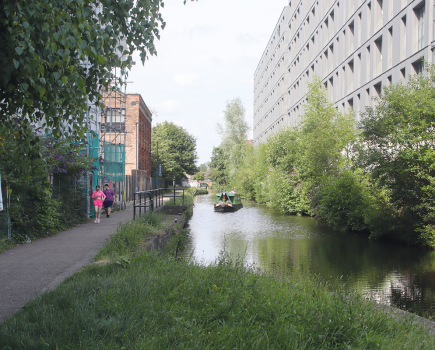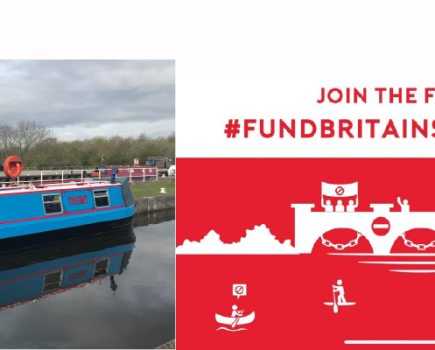Visiting the Basingstoke Canal may take a little more planning than some waterways, but it’s worth it to cruise a lovely waterway with abundant wildlife, enticing pubs and a warm welcome from local people, as Julie Clark reports…

A springtime trip among the bluebells to The Basingstoke canal certainly blew away my lockdown cobwebs.
We had been planning to investigate the Basingstoke Canal for sometime but other trips had always seemed to take precedence so a gentle cruise, not too far from our central London home mooring seemed perfect. The Basingstoke does not exactly conjure up the idea of abundant beauty but I had been assured by a friend that it was one of the prettiest canals on the system, so, narrowboats Möbius, Coracle and Jade set off from St Pancras Cruising Club on a journey of discovery.

The Basingstoke Canal begins at Woodham Junction on The river Wey, which comes off the Thames a little before Shepperton Lock. It is navigable for 31 miles until just before the long-collapsed Greywell Tunnel. There are 29 locks to traverse, 28 of which are in four flights at the start of the canal.
Transit licences have to be purchased at Thames Lock on the River Wey at a cost of £9 per boat (less 10 percent for National Trust members) to the Basingstoke Canal where another licence is required and is purchased from the Basingstoke Canal Authority. This was £45 for the week or £65 for two weeks.

Do not get caught out at this point, as we almost did. It is necessary to produce evidence of insurance and Boat Safety Scheme certificates before you are allowed through Woodham bottom lock. Of course, my paperwork was at home and I almost had to adopt the very patient Alex from the Canal Authority as my third son for my insurance company to verify that I was insured before the lock was unchained.
Locking has to be booked in advance on these flights and a note of the opening times needs to be factored into to journey plans. The first two flights, Woodham and St. John’s which make up the first 11 locks, are open on Saturday, Sunday, Tuesday and Thursday.

We made it through and with help from a friend who was involved with the Waterway Recovery Group and who had worked on the restoration of these very locks in 1982, we ascended Woodham and St. John’s. The prettiness of the bluebell and primrose adorned lock sides was overshadowed a little by the trickiness of actually operating the locks, especially difficult for a single-hander owing to the lack of usable lock landings and the shallowness of the water at the edges. Because of this a certain amount of drifting around took place!
Since the next two flights have to be ascended the next day I would recommend mooring at the top of the St. John’s flight rather that the bottom of the Brookwood since there is absolutely nowhere to moor here unless you manage to enlist the help of a passerby and tie up to a tree. Another advantage of stopping at the top of St. John’s is that there is the golden nugget of canal travel – a launderette – and also a Co-op close to Kiln Bridge for those in need. Passing through Woking was delightful with lovely houses and beautiful gardens down to the water’s edge, all beautifully maintained with some gorgeous cabins, decking and furniture to admire on the way. The floating houseboats also look beautifully maintained though I did get the impression from one of the residents that they didn’t particularly enjoy the experience of passing traffic!

The Brookwood and Deepcut flights of locks are only operational on Monday, Wednesday and Friday. We did find these quite tricky to manage, again with a distinct lack of lock landings and a lot of detritus by way of tree branches and other floating organic matter leading to the blocking of sluices and prevention of gates from opening fully. With the hard work behind us and only one phone in the drink so far we found ourselves travelling through Deepcut. This, I have to say, was one of the most lovely parts of the canal with mature trees either side and the abundance of birds it felt almost primeval – except of course for the sporadic gunfire heard from the Army training camp on the other side of the woods.
There are interesting wartime pillboxes and anti-tank emplacements to keep a look out for as well as a wall plaque commemorating The Brigade of Guards. It was rather shallow in places, as is much of the canal, and again care has to be takennot to ground or catch wood in the propeller. Also keep and eye out for several sunken working boats lying sadly along the water edge.

Having reached Mychett Canal Centre, which has full services, we learned a little of the history and enjoyed a well earned rest. Just around the corner there are lovely moorings on the side of Mychett Lake, these were however, occupied by six boats from the Byfleet Boat Club, which, like us were treated with much interest since few boats are seen moving along this waterway. I have certainly never been so photographed and waved to; folks came running down gardens to wave and watch us pass by. So many people said how wonderful it was to actually see boats moving on the canal. Clearly this small canal is much loved by the local population and small craft, canoes and paddleboards abound.
There is one further lock at Ash Lock Depot, again with water and rubbish collection, and a mile further on is Wharf Bridge, the first of three VERY low bridges with a 5ft 10in clearance. Everything had to come off the roof and I managed with literally an inch of clearance to pass underneath. Steering whilst crouching on the floor of the boat takes some nerve but we all did it and didn’t crash into the sides. It was the same for Pondtail and Reading Road bridges, by which time we were feeling like old hands at blind-steering! These bridges prevent many craft from passing this point which is a shame because now one passes into stunning open countryside all the way to Odiham Castle.

Here we moored up and met our good friend David, deckchairs were set up and a celebratory beverage imbibed. Three weary travellers, one puppy and one parrot had reached the limit of navigation. The last few hundred yards of the canal up to Greywell Tunnel are not navigable so we walked to the end and thought how wonderful it would have been to to be able to carry on.
I loved this canal even though it was challenging at times. The locks can be a little tricky and crew is definitely an advantage. The designated moorings and services are excellent, the scenery sublime and local people warm and extremely welcoming. The one downside is that it is currently underused by travelling boats to keep the water and locks moving and clear of tree branches, which, ironically, would improve if more boats used the canal. During the summer months there is a lack of water so we were lucky to keep moving though we did still experience an occasional grounding.

On the return journey I managed to dislodge my prop shaft on a log lurking under the water so had to be ignominiously towed through the last lock and down to TLC Boats at Parvis Bridge on the River Wey where, under the guidance of the wonderful Stuart, my helper, Tim, a shim made from a Mrs Baxter’s French Onion Soup can was inserted as an improvised means of allowing the engine coupling to get a better grip on the worn prop shaft. With this in place and fingers crossed we commenced our return journey to London and I am happy to report that with just one further adjustment it held out all the way!
Should the opportunity arise I can highly recommend visiting the Basingstoke Canal and perhaps the River Wey while you are in the location. It is really very lovely with some very enticing pubs along the way, the wildlife is especially abundant and local walkers warm and welcoming.


Image(s) provided by:
Martin Ludgate







